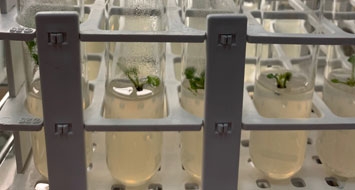April Walking Tour - Bulbs, Bulbs and More Bulbs
April 8, 2019
Sonya Anderson
Bulbs are one of my very favorite flowering plants. Maybe my favorite. It’s hard to commit to only one favorite. But if a plant has an underground storage organ holding the entire life cycle of the
Preserving Plants Using Our Tissue Culture Lab
April 5, 2019
Jameson Coopman
Plants get viruses just like humans, but how do we take care of a sick plant? It is difficult, but necessary, for some special plants like Pelargonium sidoides (South African geranium). We only have
What Horticulturalists Do in the Off-Season
March 11, 2019
Jameson Coopman
When their gardens are blanketed in snow, what do the horticulturists at Denver Botanic Gardens do? Well, for starters, they still garden! When the temperature is above freezing, our dedicated
Love is in the Air – Tie the Knot at the Gardens!
February 14, 2019
Special Events
While the Gardens offers magnificent venues for all kinds of private events, it really shines for weddings. Happy couples have been choosing to spend their special days at our York Street location for
Valentine's Day Gift Ideas
February 8, 2019
Chuck McGlothlin
“We’ve got this gift of love, but love is like a precious plant. You can’t just accept and leave it in the cupboard or just think it’s going to get on by itself. You've got to keep watering it and
February Walking Tour - Evergreens
February 1, 2019
Mike Bone
For most, the word “evergreen” evokes the thought of a pine, spruce or fir tree. These are the trees that give year-round structure to our gardens and provide points to hold our attention and direct
January Walking Tour – Winter Tropical Blossoms
January 4, 2019
Nick Snakenberg
With very few exceptions, January flowers are hard to come by in a Colorado landscape. Not so in the tropical plant collections at Denver Botanic Gardens. The Boettcher Memorial Tropical Conservatory
When I Say Gardens, You Say Party!
December 28, 2018
Special Events
The time for planning your next major event is now – don’t waste your time looking at classic board rooms or traditional ballrooms when you could instead immerse your guests in the stunning
December Walking Tour – Epiphytes in the Tropical Conservatory
December 3, 2018
Scott Preusser
From the moment your lungs take in that first breath of warm, comforting and humid air you know you have entered the Boettcher Memorial Tropical Conservatory. The Tropical Conservatory is home to over
Therapeutic Horticulture at the Gardens
November 27, 2018
Horticulture Department
As a resident of the Denver area for most of my life, it was a true gift to experience my internship in Horticultural Therapy (HT) at Denver Botanic Gardens, a place that has always inspired magic in
It’s Beginning to Look a Lot Like Blossoms of Light!
November 21, 2018
Special Events
The trees are trimmed, the halls are decked: on Friday night, we open Blossoms of Light™, and we couldn’t be more excited about this year’s display. With new features and more lights than ever before
My Newfound Confidence
November 15, 2018
Horticulture Department
My name is Jocelyn Schilling, and I have been a groundskeeper here at Denver Botanic Gardens for six months now. My main duties are using the leaf blower to clear the pathways as well as sweeping












